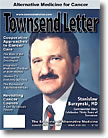


From the Townsend Letter |
||
Letter from the Publisher |
||
| Having
celebrated our 300th issue and 25 years of publication, we think
it would be appropriate to look back at some of the milestones from
our past. In the mid-1980s, for instance, we had a number of articles
that debated the pros and cons of different garlic supplements.
Several authors argued that the allicin content defined superiority
of garlic activity, while others countered that other non-allicin
factors were more important in considering using a garlic pill instead
of simply eating garlic. Ultimately, we faced what we called the
"garlic wars," which seemed to be commercial hubris and
laboratory brinksmanship in equal measure. We found ourselves in
the middle of competitors seeking to assert their claim to "who
had the best product." We walked away a little bruised and
slightly wiser after ceasing to publish further garlic reports.
First, it appeared that a laboratory assay of a supplement and a
competitors products always seemed to yield better results for the
original company ordering the lab results. Second, proprietary manufacturers
usually responded to negative reports with corresponding negative
laboratory assays about their competitors, and when that failed,
threats of litigation for printing adverse reports was the usual
next course of action. Despite a great number of words devoted to
the "garlic wars" in the Townsend
Letter, it is unclear whether allicin content truly defines
the best garlic supplement. Readers are invited to review
a listing of articles at www.townsendletter.com about the "garlic
wars" – but the articles will be available only "offline"
(through the purchase of back issues) due to legal concerns. We have enjoyed our summer break and
are now looking forward to resuming our fall season of publishing
the Townsend Letter. Part of the
fun of summer vacations is to step out from the normal routine and
try something "outside of the box." One of my favorite
magazines arriving in the office for waiting room reading is Outside.
This is my opportunity to vicariously explore the world from the
vantage point of big adventure and brute muscle power. Lacking the
latter and generally not brave enough to engage in adventuring,
we usually travel to cities and landscapes, enjoy culture and ambience,
and meet family and friends. This summer, my wife, Deborah, and
I were planning a family get-together with her mom and family in
Lake County, California. However, days before we were to begin our
trip, California lit up with the wildfires, and we were not terribly
interested in breathing the fumes. We opted to travel locally through
Northern Washington State and were delighted with the beauty of
the Cascade landscapes.
1. US Congress. Office of Technology
Assessment. Unconventional Cancer Treatments, OTA-H-405. Washington,
DC: US Government Printing Office. September 1990. |
||
![]()
Consult your doctor before using any of the treatments found within this site.
![]()
Subscriptions are available for Townsend Letter, the Examiner of Alternative Medicine magazine, which is published 10 times each year.
Search our pre-2001
archives for further information. Older issues of the printed magazine
are also indexed for your convenience.
1983-2001
indices ; recent indices
Once you find the magazines you'd like to order, please use our convenient form, e-mail subscriptions@townsendletter.com, or call 360.385.6021 (PST).
Who are we? | New
articles | Featured topics |
Tables of contents | Subscriptions | Contact
us | Links | Classifieds | Advertise | Alternative
Medicine Conference Calendar | Search site | Archives |
EDTA
Chelation Therapy | Home
© 1983-2008 Townsend Letter for
Doctors & Patients
All rights reserved.
Website by Sandy Hershelman
Designs
May 20, 2010
![]()

